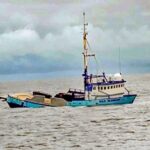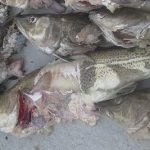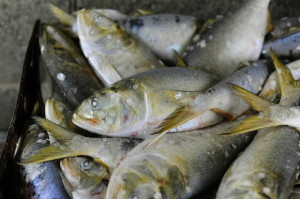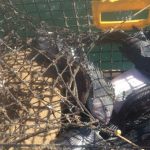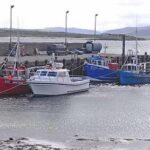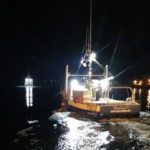Daily Archives: March 13, 2016
In the Atlantic salmon fight, Greenland proves a sticking point
 Preventing the long-imperiled Atlantic salmon from disappearing from American waters will require the U.S. to put pressure on Inuit fishermen in Greenland to stop harvesting a fish that has fed them for hundreds of years, federal officials say. The salmon were once found from Long Island Sound to Canada, but their population has cratered in the face of river damming, warming ocean waters, competition for food with non-native fish and, officials say, continued Greenlandic fishing. Now, federal officials have outlined an ambitious plan to try to save the Atlantic salmon that they say will require removing dams, creating fish passages and fostering cooperation from Inuit fishermen some 2,000 miles away from Maine, Read the rest here 13:17
Preventing the long-imperiled Atlantic salmon from disappearing from American waters will require the U.S. to put pressure on Inuit fishermen in Greenland to stop harvesting a fish that has fed them for hundreds of years, federal officials say. The salmon were once found from Long Island Sound to Canada, but their population has cratered in the face of river damming, warming ocean waters, competition for food with non-native fish and, officials say, continued Greenlandic fishing. Now, federal officials have outlined an ambitious plan to try to save the Atlantic salmon that they say will require removing dams, creating fish passages and fostering cooperation from Inuit fishermen some 2,000 miles away from Maine, Read the rest here 13:17
Western Pacific Regional Fishery Management Council meeting in Honolulu March 15 – 17, 2016
 The Western Pacific Regional Fishery Management Council convenes March 15 to 17, at Fuller Hall, YWCA, 1040 Richards St., Honolulu. Fishermen, other stakeholders and members of the public are invited to participate in the meeting and decision-making for federally managed fisheries in the offshore waters of Hawai’i, the Territories of American Samoa and Guam, Commonwealth of the Northern Mariana Islands (CNMI) and US Pacific Remote Island Areas. Read the rest here 12:17
The Western Pacific Regional Fishery Management Council convenes March 15 to 17, at Fuller Hall, YWCA, 1040 Richards St., Honolulu. Fishermen, other stakeholders and members of the public are invited to participate in the meeting and decision-making for federally managed fisheries in the offshore waters of Hawai’i, the Territories of American Samoa and Guam, Commonwealth of the Northern Mariana Islands (CNMI) and US Pacific Remote Island Areas. Read the rest here 12:17
Salmon permit prices plunge while halibut soars
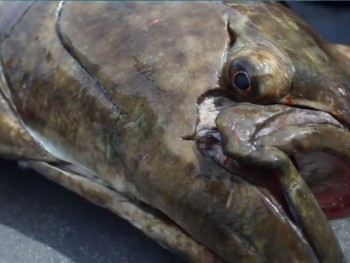 Fire sale salmon prices last year and a dim outlook for the upcoming season have caused the value of Alaska fishing permits to plummet. At the other extreme, the prices for halibut catch shares have soared to “unheard-of levels,” according to Olivia Olsen of Alaskan Quota and Permits at Petersburg. This year’s small increase in the halibut quota combined with hopes of a repeat of $6 to $7 per pound prices was enough to send quota share prices skyrocketing. “There was a big rush after the halibut numbers were announced in late January,” said Olsen of Petersburg. Read the rest here 10:32
Fire sale salmon prices last year and a dim outlook for the upcoming season have caused the value of Alaska fishing permits to plummet. At the other extreme, the prices for halibut catch shares have soared to “unheard-of levels,” according to Olivia Olsen of Alaskan Quota and Permits at Petersburg. This year’s small increase in the halibut quota combined with hopes of a repeat of $6 to $7 per pound prices was enough to send quota share prices skyrocketing. “There was a big rush after the halibut numbers were announced in late January,” said Olsen of Petersburg. Read the rest here 10:32
Nova Scotia lobster industry facing challenging season
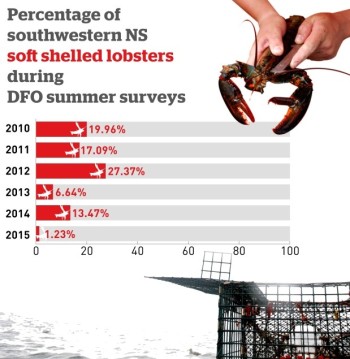 Seafood buyers are reporting high lobster mortality and poor quality, which a federal scientist says may be because lobsters are extra fragile this year in Canada’s largest lobster region off southwestern Nova Scotia. Fishermen are catching lobsters, bigger than ever, in “crazy, crazy numbers,” says Joel German, plant manager of I. Deveau Fisheries in Barrington Passage, but this winter, more than the usual amount have soft shells. “It’s not the same lobster as it used to be, so we can’t hold them as long,” he said. Lobsters generally grow out of and then shed their shells once a year in a process called moulting. As the shells grow back, they’re soft, making the lobster easier to hurt — and harder to store and ship. Read the rest here 09:58
Seafood buyers are reporting high lobster mortality and poor quality, which a federal scientist says may be because lobsters are extra fragile this year in Canada’s largest lobster region off southwestern Nova Scotia. Fishermen are catching lobsters, bigger than ever, in “crazy, crazy numbers,” says Joel German, plant manager of I. Deveau Fisheries in Barrington Passage, but this winter, more than the usual amount have soft shells. “It’s not the same lobster as it used to be, so we can’t hold them as long,” he said. Lobsters generally grow out of and then shed their shells once a year in a process called moulting. As the shells grow back, they’re soft, making the lobster easier to hurt — and harder to store and ship. Read the rest here 09:58


































